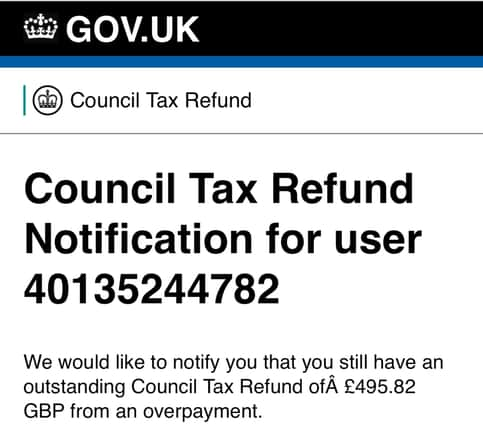Police issue warning about sophisticated council tax email scam - here’s how to spot it


Police are issuing a warning to the public to be aware of an email scam designed to directly target bank accounts.
The email claims that the recipient is entitled to a council tax refund.
What’s the scam?


Advertisement
Hide AdAdvertisement
Hide AdThe email states it is a ‘council tax refund notification’ and that you can claim your refund quickly by following a link within the email.
The link will ask you for your personal details that will allow the scammers to access your bank details (Photo: JPIMedia)
“You can get your refund fast, straight into your bank account, if you claim online through your Council Tax Account,” the scam email reads.
A clickable link follows, that reads “Get Your Refund”. However, clicking on the link will lead the recipient to a website where hackers will be able to gain access to their bank details.


Looks realistic
Advertisement
Hide AdAdvertisement
Hide AdThe email is causing concern as it looks legitimate. It contains the UK Government logo, and at the bottom of the email actually warns against the dangers of scams and offers advice for those who are worried about them.
“Do not reply to it or click on any links,” the email states.
The scammers try and increase their legitimacy by drawing attention to dangerous scam emails (Photo: JPIMedia)


It continues, “Report the suspicious email to Council Tax - to find out how, go to GOV.UK and search for ‘Avoid and report internet scams and phishing.’”
Advertisement
Hide AdAdvertisement
Hide AdOther scam emails can often be identified through the sender’s email address, as they often appear as a random collection of numbers and letters.
This email however comes from “UK Council Tax Office” and their address is “[email protected]”.
Warning from the police
On Saturday 15 June, the Forth Valley Police shared and image of the email and tweeted, “#ScamAlert - An email received by a Forth Valley resident today (15 June 2019). Please share with friends and family who are not on social media. Stop! Delete as this is a phishing attack.”
On the Forth Valley Police facebook page, they shared another warning about the scam, writing, “Do not click on the link, delete the email.
Advertisement
Hide AdAdvertisement
Hide AdThe email claims to be coming from the council tax branch of the HMRC (Photo: JPIMedia)
“If you are in doubt of any unsolicited emails, please visit the official website or make contact through an official number.”
What should I do if I got that email?
The main thing to do is avoid clicking on any links within the email and delete it immediately.
You can read about how to report phishing emails on the government website here. You can also email [email protected]
How to spot a scam email
Advertisement
Hide AdAdvertisement
Hide AdThere are a variety of things to keep an eye out for when it comes to spotting a phishing scam.
On the HMRC website, it states that you’ll never receive an email, text message or phone call from HMRC which tells you about a tax rebate or penalty, or asks for personal or payment information.
Which? has also compiled a checklist to look at if you’re unsure about the validity of an email. They advise:
A scam email will usually have a strange email address. Sometimes they’ll try and spoof a genuine sender name, but you can check the email address by right-clicking on the sender name, that will allow you to see the email address behind it.Does the email open by greeting you impersonally - simply using terms like “customer” or your email address rather than your real name?Is it asking for personal or bank details? “If an email is asking you to update or re-enter your personal or bank details out of the blue, it is likely going to be a scam,” Which? Says.Does the email have bad spelling, grammar or is laid out poorly? While scammers have gotten more sophisticated, this is still a tell tale sign of a scam.
Advertisement
Hide AdAdvertisement
Hide AdWhich? says, “More common is to see a real lack of consistency with the presentation of the email, which may include several different font styles, font sizes and a mismatch of logos.”
The bottom line is that if you’re unsure about the email in anyway, you should operate on the side of caution and get in touch with the organisation to verify that it's real.
This article originally appeared on our sister site Sunderland Echo